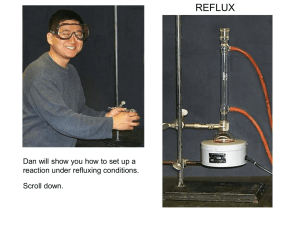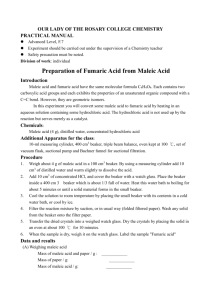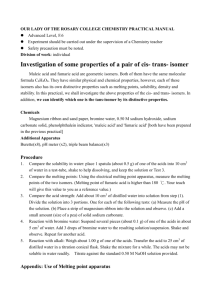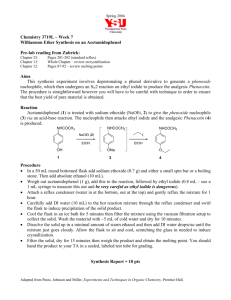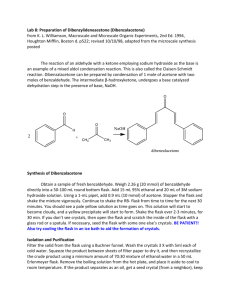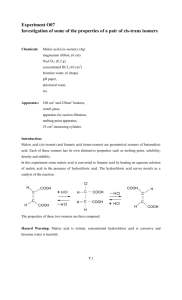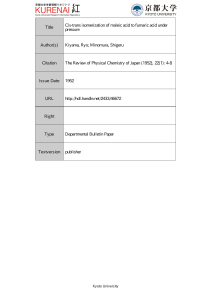Experiment V-C: Synthesis of Fumaric Acid
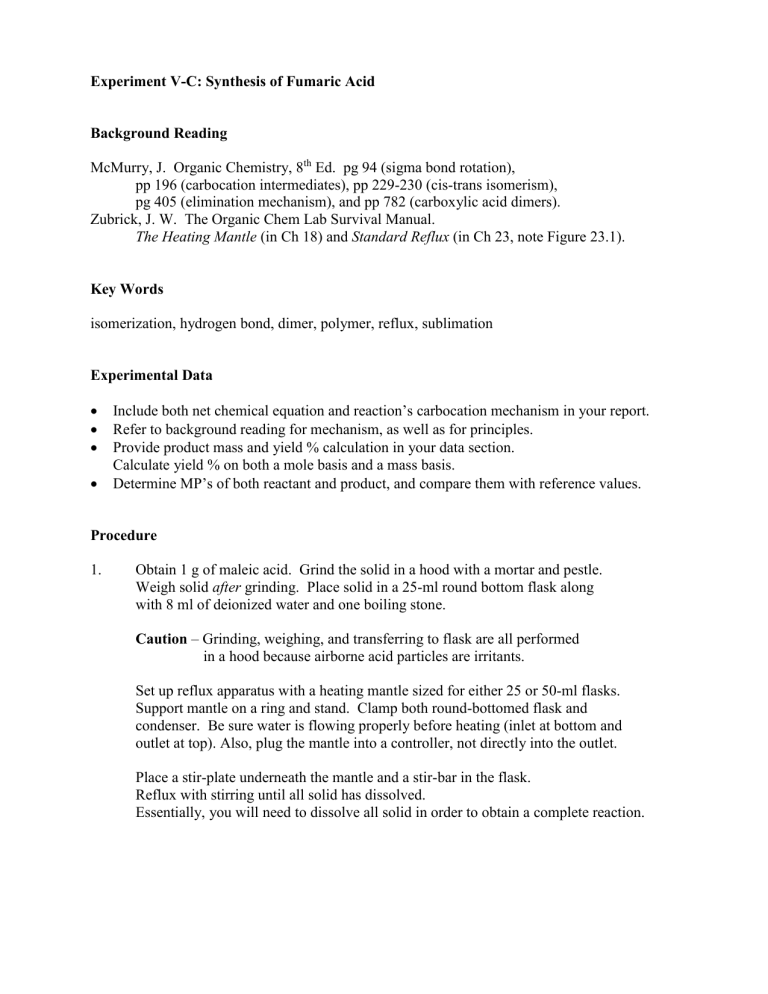
Experiment V-C: Synthesis of Fumaric Acid
Background Reading
McMurry, J. Organic Chemistry, 8 th
Ed. pg 94 (sigma bond rotation), pp 196 (carbocation intermediates), pp 229-230 (cis-trans isomerism), pg 405 (elimination mechanism), and pp 782 (carboxylic acid dimers).
Zubrick, J. W. The Organic Chem Lab Survival Manual.
The Heating Mantle (in Ch 18) and Standard Reflux (in Ch 23, note Figure 23.1).
Key Words isomerization, hydrogen bond, dimer, polymer, reflux, sublimation
Experimental Data
Include both net chemical equation and reaction’s carbocation mechanism in your report.
Refer to background reading for mechanism, as well as for principles.
Provide product mass and yield % calculation in your data section.
Calculate yield % on both a mole basis and a mass basis.
Determine MP’s of both reactant and product, and compare them with reference values.
Procedure
1.
Obtain 1 g of maleic acid. Grind the solid in a hood with a mortar and pestle.
Weigh solid after grinding. Place solid in a 25-ml round bottom flask along with 8 ml of deionized water and one boiling stone.
Caution – Grinding, weighing, and transferring to flask are all performed in a hood because airborne acid particles are irritants.
Set up reflux apparatus with a heating mantle sized for either 25 or 50-ml flasks.
Support mantle on a ring and stand. Clamp both round-bottomed flask and condenser. Be sure water is flowing properly before heating (inlet at bottom and outlet at top). Also, plug the mantle into a controller, not directly into the outlet.
Place a stir-plate underneath the mantle and a stir-bar in the flask.
Reflux with stirring until all solid has dissolved.
Essentially, you will need to dissolve all solid in order to obtain a complete reaction.
2.
Carefully, and slowly, pour 8 ml of concentrated hydrochloric acid through the top of the condenser.
Caution – Concentrated HCl solutions and vapors are corrosive and cause acid burns.
Use gloves and avoid all contact with skin, eyes, and nose.
Continue to reflux with heat for 15 more minutes.
3.
While refluxing solution, determine MP of solid maleic acid.
4.
After reflux is complete, stop heating and allow glassware to cool. Then place flask in an ice water bath to crystallize the product. The product is less soluble than the reactant due to the arrangement of its intermolecular bonds. Fumaric acid can form long hydrogen-bonded chains (which are insoluble), whereas maleic acid generally dimerizes (and is soluble).
5.
Collect product crystals by vacuum filtration using 55-mm filter paper in a Buchner funnel with a 250-ml vacuum flask.
6.
Rinse the round bottom flask and crystals with cold (5 o C) deionized water.
If possible, neutralize the filtrate with NaOH and flush down the drain with tap water.
7.
Dry crystals in oven at 100 o C for 10 minutes. Weigh dried product, and then obtain
MP. In order to obtain the MP, a sealed capillary tube must be used because fumaric acid can sublime. That is, the solid becomes gas with a normal (1 atm) sublimation point approximately 200 o
C. Work with instructor to seal capillary tubes for two MP trials. Dispose of crystals in the labeled waste jar.
Caution - Do not use glass thermometer in Mel-Temp for this step.
The MP is above its range and it can shatter.
Use digital thermometer only.
Post-Lab Q’s
1.
Explain why maleic acid is weighed after grinding, rather than before.
Also, explain the grinding procedure and location.
2.
Decolorizing carbon, a solid which was used in the recrystallization experiment, works by bonding with polar compounds. Predict the consequences if it is used to purify the crystallized fumaric acid product (polar) in step 7.
3.
If the product crystals are not completely dried when determining the melting point, explain the particular (erroneous) phase change temperature that might be observed.
4.
Explain in terms of rate laws and/or reaction quotients why the product’s low solubility favors the forward reaction over the reverse. The forward rate law is rate = k[maleic acid] n
and the reverse rate law is: rate = k[fumaric acid] n
.
Consider how the rate laws are affected by the respective solubilities.
5.
Refer to steps 4 and 7, as well as the background reading (cis-trans and dimers).
Create skeleton structures showing the intermolecular hydrogen bonding of maleic acid and fumaric acid. Explain the relative solubilities and melting points in terms of their intermolecular structure (due to H-bonding). That is, explain based on your drawings how the two isomers dimerize or polymerize differently.

